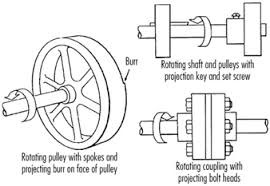Safety Policies and Procedures Manual
Chapter 2: General Workplace Safety
Machinery Safeguards
SPPM 2.71
For more information contact:
Environmental Health and Safety
509-335-3041
Overview
Departments are to use safeguards to protect employees and students from hazards associated with operating machines. Machine safeguards are generally physical barriers that either enclose or isolate hazards.
When safeguards cannot be used during maintenance, service, and repairs, personnel are to disconnect and control (e.g., lockout) all machine power sources to prevent inadvertent activation (see SPPM 2.73).
Responsibility
Departmental Administrators
Departmental administrators are responsible for ensuring that machines used for work, teaching, and research are equipped and maintained with appropriate safeguards.
Supervisors/Faculty
Supervisors and faculty are responsible for training employees and students in the proper use of machinery and safeguards in accordance with the manufacturer’s instructions. This should be a part of the safety orientation (see SPPM 2.16).
Employees/Students
Employees and students must properly use machines and safeguards at all times. Safeguards may only be removed during maintenance, service, and repairs when power sources are disconnected and controlled (e.g., locked out). See SPPM 2.73.
Employees and students are not to wear loose clothing, neckties, rings, or other jewelry that could be caught or entangled in moving parts. Employees and students whose hair is long enough to be caught or entangled in moving parts are to wear caps, hair nets, or other protection which confines hair.
Inspection
Machines are to be inspected before each use in accordance with the manufacturer’s instructions. This process includes inspecting the operating controls, safety devices and guards, electrical cords, power transmission devices, and points-of-operation for obvious defects. Machine and equipment inspections with observed conformance to the specifications in this section do not require documentation unless specified in the user’s manual, by rule or by policy. Users must document nonconformance by hazard notification (see SPPM 2.52) and tag out affected equipment (see SPPM 2.73).
Additionally, as part of the department’s annual self-inspection, supervisors are to check all machine operations in order to identify hazardous areas or processes. See SPPM 2.50 for self-inspection procedures.
Safeguards
Obtain or design safeguards to completely enclose or prohibit access to hazards by reaching through, over, under, or around the guards. The safeguards are to be securely affixed to the machine or other attachment points. The safeguards are not to create a hazard, e.g., cutting hazard.
Operations to Be Safeguarded
Safeguard the following two types of operations by using physical barriers that either enclose or isolate the hazard(s):
- Points-of-operation: Locations where the material being processed comes into direct contact with the machinery. This is where shaping, boring, forming, drilling, or cutting occurs.
- Power transmission points: Mechanical components that transmit energy and motion from the power source to the points-of-operation. Power transmission points include gears, drive shafts, cams, rods, belts/pulleys, and chain/sprockets.
Examples
Examples of points-of-operation and power transmission points are:
Machine Controls
Machines are to be equipped with the following types of controls:
- The operator must be able to turn off the power to the machine without leaving the point-of-operation.
- Operating controls must be within easy reach of the operator. The operator should not have to reach over a hazard to make adjustments.
- After a power failure the machine must not automatically restart upon restoration of power. The operator must have to activate a reset switch to start the machine.
- Operating treadles are to be guarded against accidental tripping, e.g., a cover.
- Powered feed rolls or other moving parts on feeder attachments are to be guarded.
- Machines should be equipped with energy isolating devices (e.g., circuit breaker, disconnecting switch) designed to accept a lockout device during maintenance, service, or repair activities (see SPPM 2.73).
Machine Guarding Hazards–Reporting and Correction
Employees/Students
Report hazards directly to the supervisor or use a Hazard Notification form (see SPPM 2.52).
Do not use a machine designated as unsafe. Usually such machinery is tagged, posted, locked, fenced, or otherwise designated as unfit for use.
Resume operation only after the hazard has been corrected and the machine has been declared safe to use by a supervisor, faculty member, or qualified repair person.
Supervisors/Faculty
Upon observation or notification of a machine not equipped with proper safeguards, a supervisor or faculty member is to remove the machine from service.
Notify employees and/or students that the machine is not to be operated. Place a warning notification, e.g., tag or sign, on the machine designating it as unsafe and not to be operated. Prevent use by disconnecting and locking out the power source(s) or other effective means, such as installing barriers or physically removing the machine.
Assistance
Contact the applicable campus Environmental Health and Safety (EH&S) regarding machine safety:
- WSU Pullman EH&S: telephone 509-335-3041
- WSU Spokane EH&S: telephone 509-358-7621
Note: WSU Spokane EH&S also provides information and assistance to WSU Health Sciences—Yakima (which includes College of Nursing—Yakima and College of Pharmacy and Pharmaceutical Sciences—Yakima).
- WSU Tri-Cities EH&S: telephone 509-372-7163
- WSU Vancouver EH&S: telephone 360-546-9706
Personnel at WSU locations not listed above may contact WSU Pullman EH&S for assistance.
_______________________
Revisions: Apr. 2021 – moved from SPPM 3.62 (Rev. 128); Mar. 2000 (Rev. 30); June 1986 – new policy (Rev. 1).



